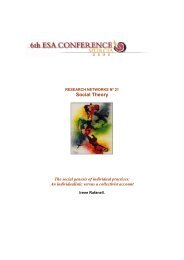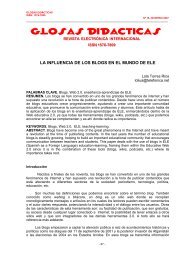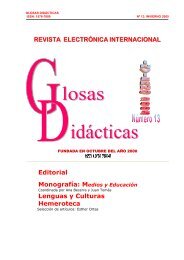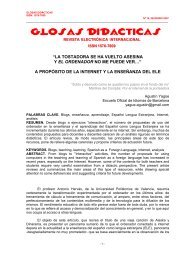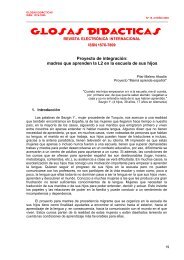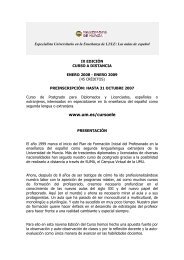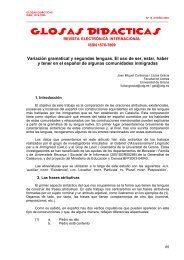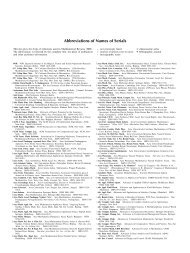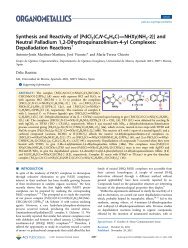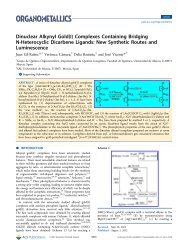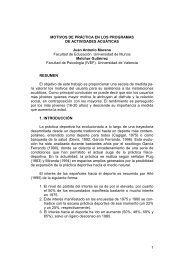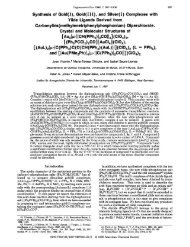623 By dual-form adverb I refer to an item derived from an ...
623 By dual-form adverb I refer to an item derived from an ...
623 By dual-form adverb I refer to an item derived from an ...
Create successful ePaper yourself
Turn your PDF publications into a flip-book with our unique Google optimized e-Paper software.
THE DEVELOPMENT OF DUAL-FORM ADVERBS: LATE/ LATELY<br />
MILAGROS CHAO CASTRO 1<br />
University of S<strong>an</strong>tiago de Compostela<br />
BASTRACT. A <strong>dual</strong>-<strong>form</strong> <strong>adverb</strong> is unders<strong>to</strong>od here as <strong>an</strong> <strong>item</strong> which derives <strong>from</strong> <strong>an</strong> elementary<br />
adjective <strong>an</strong>d which presents two different <strong>form</strong>s. One of these is <strong>form</strong>ally identical with the elementary<br />
adjective, while the other <strong>form</strong> has been created, apparently, by me<strong>an</strong>s of derivation, that is, by adding<br />
the suffix -ly <strong>to</strong> the elementary adjective. An illustrative example of a <strong>dual</strong>-<strong>form</strong> <strong>adverb</strong> is late (adv.), <strong>an</strong>d<br />
lately (adv.), <strong>from</strong> late (elementary adjective) (Nevalainen 1994a: 249). This paper tries <strong>to</strong> clarify the<br />
origin of these <strong>adverb</strong>ial <strong>form</strong>s by carrying out a thorough <strong>an</strong>alysis of the word-<strong>form</strong>ation processes<br />
related <strong>to</strong> their appear<strong>an</strong>ce, namely conversion <strong>an</strong>d derivation.<br />
KEY WORDS: <strong>dual</strong>-<strong>form</strong> <strong>adverb</strong>, conversion, derivation, his<strong>to</strong>rical evolution.<br />
RESUMEN. Una doble <strong>form</strong>a <strong>adverb</strong>ial se puede definir como un <strong>adverb</strong>io que deriva de un<br />
adjetivo elemental y que presenta dos vari<strong>an</strong>tes. Una de estas vari<strong>an</strong>tes es <strong>form</strong>almente idéntica al<br />
adjetivo elemental del que deriva, mientras que la otra <strong>form</strong>a <strong>adverb</strong>ial ha sido creada aparentemente<br />
por medio de un proceso de derivación, es decir, añadiéndole el sufijo –ly al adjetivo elemental. Un<br />
ilustrativo ejemplo de una doble <strong>form</strong>a <strong>adverb</strong>ial es late/lately, en la que ambas vari<strong>an</strong>tes <strong>adverb</strong>iales<br />
deriv<strong>an</strong> del adjetivo elemental late (Nevalainen 1994a: 249). Este artículo pretende clarificar el origen<br />
de estas dobles <strong>form</strong>as <strong>adverb</strong>iales a través de un exhaustivo <strong>an</strong>álisis de los procesos de <strong>form</strong>ación de<br />
palabras implicados en su aparición: conversión y derivación.<br />
PALABRAS CLAVE: doble <strong>form</strong>a <strong>adverb</strong>ial, conversión, derivación, evolución histórica.<br />
1. INTRODUCTION<br />
<strong>By</strong> <strong>dual</strong>-<strong>form</strong> <strong>adverb</strong> I <strong>refer</strong> <strong>to</strong> <strong>an</strong> <strong>item</strong> <strong>derived</strong> <strong>from</strong> <strong>an</strong> elementary adjective (Ungerer<br />
1988: 31) which presents two <strong>adverb</strong>ial vari<strong>an</strong>ts, namely the suffixless <strong>an</strong>d the suffixed <strong>form</strong>s,<br />
e.g. slow/ slowly, short/ shortly (Nevalainen 1994a: 248-249). The aim of this paper is<br />
clarifying the origin of these <strong>adverb</strong>ial <strong>form</strong>s by studying the word-<strong>form</strong>ation processes<br />
involved in their development, namely conversion <strong>an</strong>d derivation.<br />
Therefore, the first section (section 2) is devoted <strong>to</strong> the <strong>an</strong>alysis of the word-<strong>form</strong>ation<br />
processes that give rise <strong>to</strong> both the suffixed <strong>an</strong>d the suffixless <strong>adverb</strong>ial <strong>form</strong>s, namely<br />
conversion <strong>an</strong>d derivation. Section 3 presents a graphic representation of the in<strong>form</strong>ation<br />
depicted in the previous sections applied <strong>to</strong> the <strong>dual</strong>-<strong>form</strong> <strong>adverb</strong> late/lately. Finally, the last<br />
part of this paper, section 4, provides the conclusions drawn <strong>from</strong> this research.<br />
2. WORD-FORMATION PROCESSES INVOLVED IN THE CREATION OF DUAL-FORM ADVERBS<br />
2.1. Conversion<br />
This section will explain the appear<strong>an</strong>ce of the suffixless <strong>form</strong> of <strong>dual</strong>-<strong>form</strong> <strong>adverb</strong>s <strong>an</strong>d<br />
those aspects related <strong>to</strong> its development. Therefore, conversion is one of the word-<strong>form</strong>ation<br />
processes which are relev<strong>an</strong>t here.<br />
Conversion is defined by Quirk et al. (1985: 1558) as a “derivational process whereby<br />
<strong>an</strong> <strong>item</strong> is adapted or converted <strong>to</strong> a new word class without the addition of <strong>an</strong> affix.”<br />
His<strong>to</strong>rically speaking, this word-<strong>form</strong>ation process is thought <strong>to</strong> be related <strong>to</strong> the<br />
weakening of unstressed vowels <strong>to</strong> schwa <strong>an</strong>d its subsequent fall in English (Jespersen 1972:<br />
153). In OE new <strong>adverb</strong>s were <strong>form</strong>ed by adding the suffix –e <strong>to</strong> adjectives, e.g. hard (adj.)<br />
<strong>623</strong>
<strong>an</strong>d hard-e (adv.). However, in late OE unstressed vowels beg<strong>an</strong> <strong>to</strong> suffer a process of<br />
levelling <strong>an</strong>d weakening <strong>to</strong> schwa. During ME schwa fell, thus causing the <strong>form</strong>al<br />
identification between the adjective <strong>an</strong>d the <strong>adverb</strong>, e.g. hard (adj.) <strong>an</strong>d hard (adv.). At the<br />
same time, this homomorphy, which was the result of a chain of phonological ch<strong>an</strong>ges which<br />
included the levelling <strong>to</strong> /e/ of unstressed vowels, the weakening of this /e/ <strong>to</strong> schwa <strong>an</strong>d its<br />
subsequent loss, 2 was reinterpreted as the outcome of a process of conversion at later<br />
indivi<strong>dual</strong> stages. This interpretation was easily carried out due <strong>to</strong> the sem<strong>an</strong>tic connection<br />
existing between the adjective <strong>an</strong>d the <strong>adverb</strong>, since, as March<strong>an</strong>d (1969: 11) points out,<br />
“there is no derivational connection between words if they have no sem<strong>an</strong>tic features in<br />
common.” Therefore, speakers assumed this homomorphy as conversion <strong>from</strong> adjectives <strong>to</strong><br />
<strong>adverb</strong>s, <strong>an</strong>d eventually they applied this process <strong>to</strong> other adjectives, by me<strong>an</strong>s of <strong>an</strong>alogical<br />
extension, <strong>to</strong> obtain new <strong>adverb</strong>s. The following example illustrates how the existence of hard<br />
(adj.) <strong>an</strong>d hard (adv.) is unders<strong>to</strong>od as the outcome of conversion, <strong>an</strong>d how conversion is<br />
applied <strong>to</strong> a more recent adjective, cle<strong>an</strong>, <strong>to</strong> <strong>form</strong> a new <strong>adverb</strong>, cle<strong>an</strong>.<br />
(1) a. hard (adj. OE heard): hard (adv. OE heard + -e) (OED s.vv. hard, adj., hard,<br />
adv.)<br />
b. cle<strong>an</strong> (adj. OE clæne): cle<strong>an</strong> (adv. <strong>from</strong> the adjective) (OED s.vv. cle<strong>an</strong>, adj., cle<strong>an</strong>,<br />
adv.)<br />
Thus, according <strong>to</strong> what has been said, two types of homomorphic pairs c<strong>an</strong> be<br />
distinguished: (a) those resulting <strong>from</strong> the process that I have called his<strong>to</strong>rical evolution, <strong>an</strong>d<br />
(b) those resulting <strong>from</strong> the application of conversion by me<strong>an</strong>s of a false <strong>an</strong>alogy with type<br />
(a). Moreover, type (a) is also sustained by the fact that one of the main characteristics of<br />
conversion is that it starts with one single <strong>form</strong> <strong>an</strong>d it ends with two, not the other way round.<br />
Therefore, the homomorphic pairs of type (a) could never be the outcome of conversion.<br />
Nevertheless, distinguishing between these two types of homomorphy is one of the first<br />
problems which arise when these <strong>form</strong>ally identical words are studied.<br />
A second problem related <strong>to</strong> these pairs of homomorphic words, adjective <strong>an</strong>d <strong>adverb</strong>,<br />
created by conversion is discerning which one derives <strong>from</strong> the other. So far, it has been<br />
assumed that <strong>adverb</strong>s are <strong>derived</strong> <strong>from</strong> adjectives, though conversion in the opposite direction<br />
would also be possible: <strong>an</strong> adjective <strong>derived</strong> <strong>from</strong> <strong>an</strong> <strong>adverb</strong> (the adjective near derives <strong>from</strong><br />
the comparative <strong>form</strong> of the <strong>adverb</strong> nigh (OED s.v. near, adv²)). Thus, determining<br />
directionality is one of the most interesting <strong>an</strong>d complicated problems of conversion. This is a<br />
controversial issue which has been discussed by several authors who have proposed different<br />
criteria. Some of these criteria have been <strong>an</strong>alyzed by Balteiro (2004: 286ff), who has applied<br />
them <strong>to</strong> her study. On the one h<strong>an</strong>d, she deals with two diachronic criteria, namely etymology<br />
<strong>an</strong>d dates of first records, <strong>an</strong>d, on the other, she <strong>an</strong>alyzes synchronic criteria such as the<br />
following:<br />
(a) Sem<strong>an</strong>tic dependence<br />
(b) Restriction of usage<br />
(c) Sem<strong>an</strong>tic r<strong>an</strong>ge<br />
(d) Sem<strong>an</strong>tic pattern<br />
(e) Morphological type<br />
(f) Stress<br />
(g) Principle of relative markedness<br />
(h) Phonetic shape<br />
The data in the present study will mainly be subjected <strong>to</strong> the etymological criterion,<br />
which is essential <strong>to</strong> identify conversion. The dates of first records will also be taken in<strong>to</strong><br />
account, though with great caution. The remaining criteria, not being really determining, will<br />
be used only when these two diachronic criteria are not conclusive enough.<br />
624
2.2. Derivation<br />
Besides conversion, other processes of word-<strong>form</strong>ation are involved in the development<br />
of <strong>dual</strong>-<strong>form</strong> <strong>adverb</strong>s. As seen in the previous section, conversion has been used <strong>to</strong> explain the<br />
appear<strong>an</strong>ce of the suffixless <strong>adverb</strong>ial <strong>form</strong>s. Now derivation, more specifically suffixation,<br />
will be used <strong>to</strong> justify the development of the suffixed <strong>form</strong>s.<br />
One of the most productive <strong>adverb</strong>ial suffixes in PDE is –ly (Quirk at al. 1985: 438ff),<br />
which is precisely involved in the creation of <strong>dual</strong>-<strong>form</strong> <strong>adverb</strong>s. However, the <strong>an</strong>alysis of this<br />
<strong>adverb</strong>ial suffix shows the existence of a homomorphic adjectival counterpart which gives<br />
rise <strong>to</strong> a new hypothesis <strong>to</strong> explain the origin of the suffixed <strong>form</strong> of <strong>dual</strong>-<strong>form</strong> <strong>adverb</strong>s,<br />
namely conversion with <strong>an</strong> adjective in –ly.<br />
The his<strong>to</strong>ry of the <strong>adverb</strong>ial suffix –ly begins in OE. At this stage one of the most<br />
productive adjectival suffixes was –lic, e.g. winterly. Adjectives ending in –lic added the<br />
suffix –e <strong>to</strong> <strong>form</strong> <strong>adverb</strong>s, so –lic + -e became a very common combination which occurred in<br />
<strong>adverb</strong>s.–lice was soon reinterpreted as <strong>an</strong> <strong>adverb</strong>ial suffix <strong>an</strong>d came <strong>to</strong> be used as such with<br />
other adjectives. Moreover, in the course of time, both suffixes, the adjectival -lic <strong>an</strong>d the<br />
<strong>adverb</strong>ial –lice, became <strong>form</strong>ally identical due <strong>to</strong> his<strong>to</strong>rical evolution, thus becoming –ly.<br />
Therefore, these two suffixes are related etymologically <strong>an</strong>d are <strong>form</strong>ally identical. The<br />
Oxford English Dictionary (OED) <strong>refer</strong>s <strong>to</strong> adjectival –ly as –ly¹, <strong>an</strong>d <strong>to</strong> <strong>adverb</strong>ial –ly as –ly².<br />
An interesting question which arises here concerns the productivity 3 potential of<br />
adjectival –ly in post-OE times, that is, is the OE adjectival –ly suffix still productive <strong>from</strong><br />
ME onwards, <strong>an</strong>d therefore could the <strong>adverb</strong>s in –ly be the product of conversion with the<br />
corresponding adjective?<br />
The method which I have used <strong>to</strong> measure the productivity of adjectival -ly¹ is looking<br />
for the type frequency of this suffix <strong>from</strong> 1200 onwards, taking in<strong>to</strong> account only those<br />
adjectives which do not present a homomorphic <strong>adverb</strong> in order <strong>to</strong> avoid possible cases of<br />
conversion which would erroneously alter the results. This qu<strong>an</strong>titative measure has been<br />
criticized, because it takes in<strong>to</strong> account all the types, even those created during the productive<br />
period of the affix (Plag 1999: 22, 23; 2003: 52), which may not correspond <strong>to</strong> the period<br />
under <strong>an</strong>alysis. Therefore, a high type frequency could also be the result of the productivity of<br />
that affix in past stages. In view of this potential h<strong>an</strong>dicap, I only <strong>to</strong>ok in<strong>to</strong> account<br />
neologisms <strong>form</strong>ed <strong>from</strong> 1200 onwards, as mentioned above. Along with the aforementioned<br />
criticism of the qu<strong>an</strong>titative measure, the use of the OED <strong>to</strong> carry out this search could also be<br />
the object of criticism because, according <strong>to</strong> Plag (1999: 99), the entries of this dictionary are<br />
collected <strong>from</strong> <strong>an</strong> unspecified sample <strong>an</strong>d there is some inconsistency in the sampling of<br />
indivi<strong>dual</strong> <strong>form</strong>s. However, Plag also recognizes that these disadv<strong>an</strong>tages are not strong<br />
enough <strong>to</strong> disregard the use of the OED in productivity studies. Moreover, this author defends<br />
its use considering that it offers thorough <strong>an</strong>d complete in<strong>form</strong>ation on all the words of the<br />
l<strong>an</strong>guage <strong>an</strong>d, hence, on the development of the vocabulary of English (Plag 1999: 97; 2003:<br />
52). 4<br />
The results of my measurement of productivity are provided in Table 1 below. As c<strong>an</strong><br />
be seen adjectival -ly¹ is still productive <strong>from</strong> ME onwards in the pattern noun + -ly¹ =<br />
adjective (72.13%), whereas the pattern adjective + -ly¹ = adjective is less frequent (16.12%),<br />
thus less productive. 5<br />
625
72.13% <strong>from</strong> a noun (264 <strong>item</strong>s), e.g. citizenly.<br />
366 adjs. in -ly¹ without<br />
homomorphic adv.<br />
after 1200<br />
16.12% <strong>from</strong> <strong>an</strong> adj. (59 <strong>item</strong>s), e.g. cautionately.<br />
9.01% <strong>from</strong> a doubtful word-class (33 <strong>item</strong>s), e.g.<br />
weeply (weep n. or v.).<br />
2.73% <strong>from</strong> other word-classes (10 <strong>item</strong>s), e.g. chokely (<strong>from</strong> a verb),<br />
forthly (<strong>from</strong> <strong>an</strong> <strong>adverb</strong>).<br />
Table 1. Productivity of adjectival -ly¹ <strong>from</strong> ME onwards.<br />
The productivity of -ly¹ after ME leaves the door open for a new hypothesis <strong>to</strong> explain<br />
the origin of the suffixed <strong>form</strong> of <strong>dual</strong>-<strong>form</strong> <strong>adverb</strong>s, namely conversion with <strong>an</strong> adjective in -<br />
ly¹. Thus this adjective in -ly¹ would be <strong>an</strong> intermediate step between the elementary adjective<br />
<strong>an</strong>d the suffixed <strong>adverb</strong>ial <strong>form</strong>. In order <strong>to</strong> prove this hypothesis, the OED was, once again,<br />
used. Contrary <strong>to</strong> the measurement of the productivity of the suffix -ly¹ discussed above, in<br />
which homomorphic pairs were disregarded, this hypothesis is based on the relation between<br />
homomorphic <strong>item</strong>s as regards conversion <strong>an</strong>d directionality. A <strong>to</strong>tal of 468 homomorphic<br />
pairs which seem <strong>to</strong> have originated in a process of conversion after ME were found in the<br />
OED. After <strong>an</strong>alyzing them, taking in<strong>to</strong> account etymology <strong>an</strong>d the dates of first records, the<br />
results are showed in Table 2:<br />
468 –ly adjs. with a<br />
corresponding<br />
homomorphic –ly adv.<br />
45.63% of the –ly adjectives derive <strong>from</strong> their homomorphic <strong>adverb</strong>s, e.g.<br />
stilly (214 <strong>item</strong>s).<br />
38.65% of these <strong>form</strong>s have the adjective as the original <strong>form</strong>, e.g. behovely<br />
(181 <strong>item</strong>s).<br />
15.46% represent those doubtful cases in which the same date is found for<br />
both the adjective <strong>an</strong>d the <strong>adverb</strong>, e.g. whitely (73 <strong>item</strong>s).<br />
Table 2. Conversion between adjectives <strong>an</strong>d <strong>adverb</strong>s in –ly.<br />
The high proportion of <strong>form</strong>s which have their origin in –ly adjectives (38.65%)<br />
demonstrates that the hypothesis according <strong>to</strong> which some suffixed <strong>form</strong>s of <strong>dual</strong>-<strong>form</strong><br />
<strong>adverb</strong>s could have their origin in a homomorphic adjective rather th<strong>an</strong> in the elementary<br />
adjective proper is feasible. According <strong>to</strong> this, both <strong>form</strong>s of <strong>dual</strong>-<strong>form</strong> <strong>adverb</strong>s c<strong>an</strong> derive<br />
directly <strong>from</strong> the elementary adjective by me<strong>an</strong>s of conversion <strong>an</strong>d derivation respectively, or<br />
<strong>an</strong> intermediate step c<strong>an</strong> be found between the elementary adjective <strong>an</strong>d the suffixed <strong>adverb</strong>ial<br />
<strong>form</strong>, namely <strong>an</strong> adjective in –ly. This adjectival <strong>form</strong> would give rise <strong>to</strong> the suffixed<br />
<strong>adverb</strong>ial <strong>form</strong> by me<strong>an</strong>s of conversion.<br />
3. THE ORIGIN OF THE DUAL-FORM ADVERB LATE/LATELY AND OF THE ITEMS RELATED TO IT<br />
On the basis of the in<strong>form</strong>ation provided by the OED, I have represented in Figure 1<br />
below the different steps that the <strong>dual</strong>-<strong>form</strong> <strong>adverb</strong> late/ lately <strong>an</strong>d the <strong>item</strong>s related <strong>to</strong> it, late<br />
(adj.) <strong>an</strong>d lately (adj.), have followed in their development.<br />
626
1 2 3 4<br />
897<br />
· OE · OE<br />
2 1000 1000<br />
· ME 1 · ME<br />
1400 3<br />
· eModE · eModE<br />
· lModE · lModE<br />
· PDE · PDE<br />
adj. lately adj. late adv. lately adv. late<br />
Figure 1. Graphic representation of the origin of the <strong>dual</strong>-<strong>form</strong> <strong>adverb</strong> late/ lately<br />
<strong>an</strong>d of the <strong>item</strong>s related <strong>to</strong> it<br />
Thus, according <strong>to</strong> the OED, late (adj.) has its origins in OE læt (OED s.v. late, adj.)<br />
<strong>an</strong>d it occurred for the first time in 897 (example (2)). This adjective presents a r<strong>an</strong>ge of<br />
me<strong>an</strong>ings with a clear temporal <strong>refer</strong>ence. On the other h<strong>an</strong>d, the <strong>adverb</strong> late has its origins in<br />
OE læt, lat-e (OED s.v late, adv.) <strong>an</strong>d the date of its first record is 1000 (example (3)). This<br />
<strong>adverb</strong> derives <strong>from</strong> the elementary adjective late by adding the OE <strong>adverb</strong>ial suffix –e<br />
(movement marked in Figure 1 by the blue arrow number 1 which goes <strong>from</strong> late (adj.) <strong>to</strong> late<br />
(adv.)). In the course of time, both <strong>item</strong>s become <strong>form</strong>ally identical due <strong>to</strong> the process I have<br />
labelled his<strong>to</strong>rical evolution. Therefore, no process of conversion is involved in the<br />
appear<strong>an</strong>ce of late (adv.). As regards sem<strong>an</strong>tics, late (adv.) <strong>to</strong>ok its me<strong>an</strong>ing <strong>from</strong> the<br />
elementary adjective late; hence its senses also show a clear temporal <strong>refer</strong>ence.<br />
(2) Eft wæs unræd, nalas elnes læt (Beowulf 1529) (OED s.v. late, adj.1.).<br />
(3) Late on ζeare (1000 O.E. Chron. <strong>an</strong>. 867 (Parker MS.)) (OED s.v. late, adv.2.a.).<br />
On the other h<strong>an</strong>d, the <strong>adverb</strong> lately has its origins in OE lætlice (OED s.v. lately, adv.),<br />
its pattern of <strong>form</strong>ation being the adjective late plus -ly² (the origin is indicated in the figure<br />
by me<strong>an</strong>s of the blue arrow number 2). It is recorded for the first time in 1000 (example (4)).<br />
This <strong>adverb</strong> <strong>to</strong>ok its me<strong>an</strong>ings <strong>from</strong> the elementary adjective late <strong>an</strong>d, thus, a clear temporal<br />
<strong>refer</strong>ence is present. As regards the adjective lately, the OED considers that this <strong>form</strong> is the<br />
result of adding –ly¹ <strong>to</strong> the elementary adjective late (OED s.v. lately, adj.). The date of the<br />
first record of this adjective is 1400 (example (5)) (blue arrow number 3 in the figure).<br />
(4) Ða <strong>an</strong>dswarode he him lætlice (1000 Life of Guthlac xx. (1848) 80/12) (OED s.v.<br />
lately, adv.1.).<br />
(5) He, þat yn goynge, hauys his paas large <strong>an</strong>d latly, welfare shall folwe him yn all his<br />
werkys (1400 tr. Secreta Secret., Gov. Lordsh.117) (OED s.v. lately, adj.1.).<br />
However, I do not agree with the OED in considering lately (adj.) a –ly¹ derivation. I<br />
consider the adjective lately <strong>to</strong> be the result of a process of conversion with the <strong>adverb</strong> lately,<br />
which appeared four hundred years earlier. The following arguments support my hypothesis<br />
of conversion (this hypothesis is showed in the figure by me<strong>an</strong>s of a yellow arrow which goes<br />
<strong>from</strong> lately (adv.) <strong>to</strong> lately (adj.)):<br />
627
(i) The <strong>adverb</strong> lately (1000) is recorded four hundred years earlier th<strong>an</strong> the adjective<br />
lately (1400). So late <strong>an</strong> appear<strong>an</strong>ce of the adjective with respect <strong>to</strong> the <strong>adverb</strong><br />
seems <strong>to</strong> be related not <strong>to</strong> -ly¹, but <strong>to</strong> -ly², as the result of a process of<br />
conversion. Moreover, it is not likely that the l<strong>an</strong>guage used a different pattern<br />
of <strong>form</strong>ation <strong>to</strong> create a new <strong>item</strong> which presents a homomorphic counterpart<br />
which appeared long before the new one, <strong>an</strong>d with which the new <strong>item</strong> is<br />
related etymologically.<br />
(ii) Synchronic criteria c<strong>an</strong> also be applied <strong>to</strong> lately (adv.) <strong>an</strong>d lately (adj.). In this<br />
connection, sem<strong>an</strong>tic dependence c<strong>an</strong> be observed if the time <strong>refer</strong>ence implied<br />
in the two only me<strong>an</strong>ings of lately (adj.), ‘slow’ <strong>an</strong>d ‘recent’, is taken in<strong>to</strong><br />
account.<br />
4. CONCLUSIONS<br />
The main objective of this paper has been the <strong>an</strong>alysis of all the possible origins of <strong>dual</strong><strong>form</strong><br />
<strong>adverb</strong>s. Therefore, two word-<strong>form</strong>ation processes, namely conversion <strong>an</strong>d derivation,<br />
have been used <strong>to</strong> explain the development of these <strong>adverb</strong>ial <strong>form</strong>s. Conversion with the<br />
elementary adjective has usually been considered the origin of the suffixless <strong>form</strong> of <strong>dual</strong><strong>form</strong><br />
<strong>adverb</strong>s. However, the <strong>form</strong>al overlap between the elementary adjective <strong>an</strong>d the<br />
unsuffixed <strong>adverb</strong>ial <strong>form</strong> c<strong>an</strong> also be explained by me<strong>an</strong>s of a chain of phonological ch<strong>an</strong>ges<br />
which I have subsumed under the label ‘his<strong>to</strong>rical evolution’.<br />
On the other h<strong>an</strong>d, the appear<strong>an</strong>ce of the suffixed <strong>form</strong> of <strong>dual</strong>-<strong>form</strong> <strong>adverb</strong>s is<br />
explained by me<strong>an</strong>s of derivation since most of these suffixed <strong>adverb</strong>s are created by adding –<br />
ly² <strong>to</strong> the elementary adjective. Nevertheless, <strong>an</strong>other possibility <strong>to</strong> explain the origin of this<br />
<strong>adverb</strong>ial <strong>form</strong> is presented: conversion with <strong>an</strong> adjective in –ly. The <strong>an</strong>alysis of the<br />
productivity of the adjectival suffix –ly¹ has shown that this suffix is still productive <strong>from</strong> ME<br />
onwards. Therefore, the hypothesis according <strong>to</strong> which the suffixed <strong>adverb</strong>ial <strong>form</strong> may have<br />
its origin in a process of conversion with its homomorphic adjective is feasible, since a<br />
38.65% of these <strong>adverb</strong>s present the adjective as the original <strong>form</strong>.<br />
As regards the <strong>dual</strong>-<strong>form</strong> <strong>adverb</strong> late/lately, the appear<strong>an</strong>ce of the suffixed <strong>form</strong> is<br />
explained by me<strong>an</strong>s of derivation, whereas the suffixless <strong>form</strong> is the result of his<strong>to</strong>rical<br />
evolution. Contrary <strong>to</strong> the OED, I point out conversion with the <strong>adverb</strong> lately as the origin of<br />
the suffixed adjective lately, since the <strong>form</strong>er appeared four hundred years earlier th<strong>an</strong> its<br />
adjectival homomorphic counterpart.<br />
NOTES<br />
1. Research for this paper was funded by the Au<strong>to</strong>nomous Government of Galicia (gr<strong>an</strong>t no.<br />
PGIDIT05PXIC20401PN), the Sp<strong>an</strong>ish Ministry of Education <strong>an</strong>d Science (gr<strong>an</strong>ts no.<br />
HUM2004-00940, AP2005-1012) <strong>an</strong>d the Europe<strong>an</strong> Regional Development Fund (ERDF). This support is<br />
gratefully acknowledged.<br />
2. From now on, I will <strong>refer</strong> <strong>to</strong> this chain of phonological ch<strong>an</strong>ges as his<strong>to</strong>rical evolution.<br />
3. According <strong>to</strong> Plag (2003: 44), productivity is unders<strong>to</strong>od as the property of <strong>an</strong> affix <strong>to</strong> be used <strong>to</strong> coin new<br />
complex words.<br />
4. Other authors such as Sebasti<strong>an</strong> Hoffm<strong>an</strong>n (2004) or Christi<strong>an</strong> Mair (2004: 123-125) also <strong>an</strong>alyze <strong>an</strong>d defend<br />
respectively the possibility of using the OED as a his<strong>to</strong>rical corpus.<br />
5. The remaining 2.73% <strong>an</strong>d 9.01% correspond, respectively, <strong>to</strong> those -ly <strong>item</strong>s <strong>derived</strong> <strong>from</strong> word-classes other<br />
th<strong>an</strong> nouns <strong>an</strong>d adjectives, <strong>an</strong>d <strong>to</strong> those <strong>form</strong>ations in which the category of the base admits several<br />
interpretations.<br />
628
REFERENCES<br />
Balteiro, Mª I. 2004. Conversion in English: the question of directionality <strong>an</strong>d other relev<strong>an</strong>t<br />
issues. Unpublished PhD dissertation. University of S<strong>an</strong>tiago de Compostela.<br />
Campbell, A. 1959. Old English Grammar. Oxford: Clarendon Press.<br />
Dixon, R. 1982. Where have all the adjectives gone? Berlin, New York & Amsterdam:<br />
Mou<strong>to</strong>n Publishers.<br />
Hoffm<strong>an</strong>n, S. 2004. “Using the OED quotations database as a corpus- a linguistic appraisal.”<br />
ICAME Journal 28: 17-30.<br />
Jespersen, O. 1972. Growth <strong>an</strong>d Structure of the English L<strong>an</strong>guage. Oxford: Basil Blackwell.<br />
Mair, C. 2004. “Corpus linguistics <strong>an</strong>d grammaticalization theory: Statistics, frequencies <strong>an</strong>d<br />
beyond.” In Lindquist, H. <strong>an</strong>d C. Mair (eds.). Corpus Approaches <strong>to</strong><br />
Grammaticalization in English. Amsterdam & Philadelphia: John Benjamins, 121-150.<br />
March<strong>an</strong>d, H. 1969. The Categories <strong>an</strong>d Types of Present-day English Word-Formation.<br />
München: Beck.<br />
Nevalainen, T. 1994a. “Aspects of <strong>adverb</strong>ial ch<strong>an</strong>ge in Early Modern English.” In Kas<strong>to</strong>vsky,<br />
D. (ed.). Studies in Early Modern English. Berlin: Mou<strong>to</strong>n de Gruyter, 243-259.<br />
OED = The Oxford English Dictionary on CD-ROM (1989). [2 nd ed.]. Ed. by John A.<br />
Simpson & Edmund S.C. Weiner. Oxford: O.U.P.<br />
Plag, I. 1999. Morphological Productivity: Structural Constraints in English Derivation.<br />
Berlin & New York: Mou<strong>to</strong>n de Gruyter.<br />
Quirk et al. 1985. A Comprehensive Grammar of the English L<strong>an</strong>guage. London: Longm<strong>an</strong>.<br />
Sweet, H. 1891-98. A New English Grammar. Logical <strong>an</strong>d His<strong>to</strong>rical. 2 vols. Oxford:<br />
Clarendon Press.<br />
Ungerer, F. 1988. Syntax der englischen Adverbialen (Linguistische Arbeiten 215). Tübingen:<br />
Niemeyer.<br />
629



